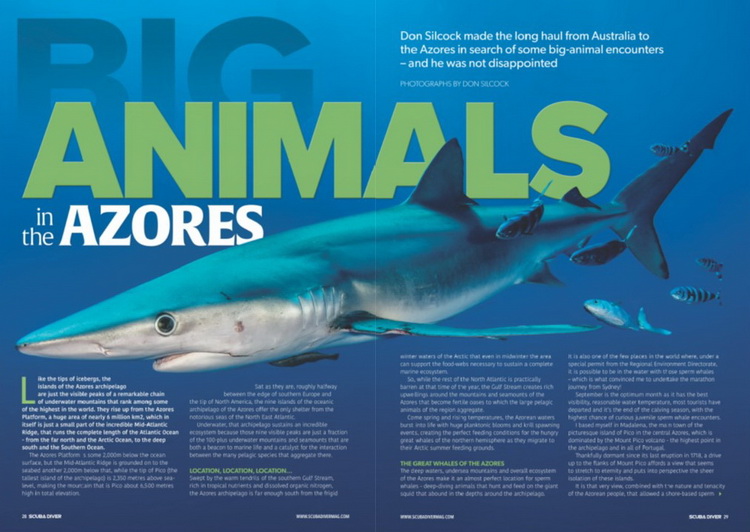Big Animals in the Azores… Like the tips of icebergs, the islands of the Azores are the peaks of a remarkable chain of underwater mountains. Which are so large, they rank among some of the highest in the world.
They rise up from the Azores Platform, a huge area of nearly 6 million km2. Which in itself is just a small part of the incredible Mid Atlantic Ridge, that runs the complete length of the Atlantic Ocean. From the far north and the Arctic Ocean, to the deep south and the Southern Ocean.
The Azores Platform is some 2000m below the ocean surface. But the Mid Atlantic Ridge is grounded on to the sea bed another 2000m below that. While the tip of Pico (the tallest island of the archipelago) is 2350m above sea-level. Making the mountain that is Pico about 6500m high in total elevation.

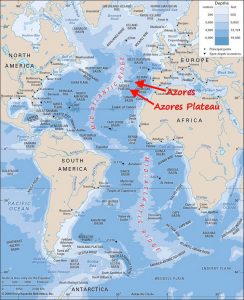 Sat as they are, roughly halfway between the edge of southern Europe and the tip of North America.
Sat as they are, roughly halfway between the edge of southern Europe and the tip of North America.
The nine islands of the oceanic archipelago offer the only shelter from the notorious seas of the North East Atlantic.
Underwater, that archipelago sustains an incredible ecosystem. Because those nine visible peaks are just a fraction of the 100+ underwater mountains and seamounts.
Which are both a beacon to marine life. And a catalyst for the interaction between the many pelagic species that aggregate there.
Big Animals in the Azores – Location, Location, Location…
Swept by the warm tendrils of the southern Gulf Stream, rich in tropical nutrients and dissolved organic nitrogen. The Azores archipelago is far enough south from the frigid winter waters of the Arctic, that even in midwinter the area can support the food-webs necessary to sustain a complete marine ecosystem.
So, while the rest of the North Atlantic is practically barren at that time of the year. The Gulf Stream creates rich upwellings around the mountains and seamounts of the Azores that become fertile oases to which the large pelagic animals of the region aggregate.
Come spring and rising temperatures the Azorean waters burst in to life with huge planktonic blooms and krill spawning events. Creating the perfect feeding conditions for the hungry great whales of the northern hemisphere as they migrate to their Arctic summer feeding grounds.
Big Animals in the Azores – The Great Whales!
The deep waters, undersea mountains and overall ecosystem of the Azores make it an almost perfect location for sperm whales. Deep-diving animals that hunt and feed on the giant squid that abound in the depths around the archipelago.
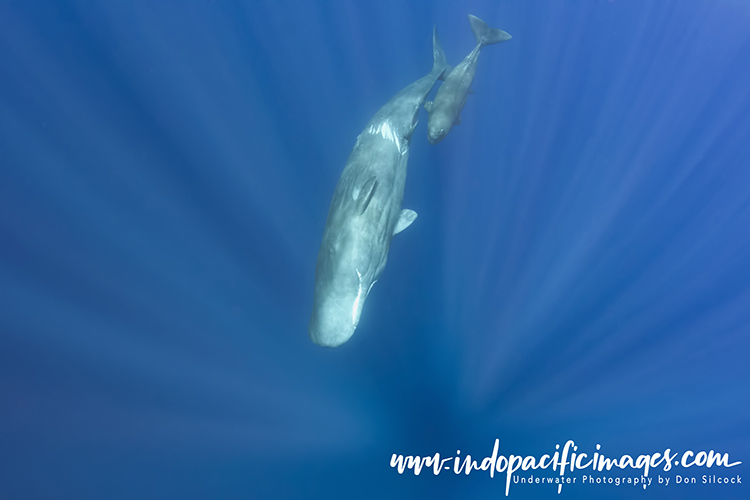
It is also one of the few places in the world where, under a special permit from the Regional Environment Directorate, it is possible to be in the water with those sperm whales. Which is what convinced me to undertake the marathon journey from Sydney!
September is the optimum month as it has the best visibility and reasonable water temperature. Plus most tourists have departed and it’s the end of the calving season with the highest chance of curious juvenile sperm whale encounters.
I based myself in Madalena, the main town of the picturesque island of Pico in the central Azores. Pico is dominated by the Mount Pico volcano – the highest point in the archipelago and in all of Portugal.

Thankfully dormant since its last eruption in 1718, a drive up to the flanks of Mount Pico affords a view that seems to stretch to eternity. And puts in to perspective the sheer isolation of these islands.
It is that very view, combined with the nature and tenacity of the Azorean people, that allowed a shore-based sperm whaling industry to succeed. Because an experienced whale-spotter can only see the ”blow” of a whale up to 50km out at sea and tell what type of whale it is.
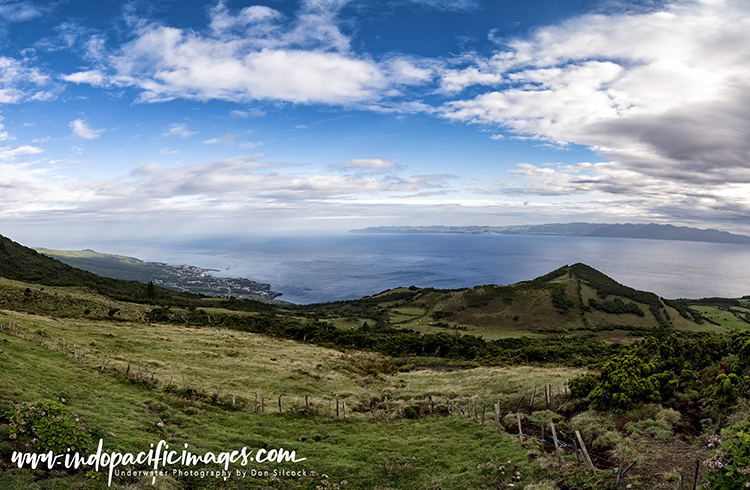
Big Animals in the Azores – Whale Watching

The whale lookouts are called “vigias”. Which are distributed around the islands at strategic locations to provide almost complete panoramic coverage.
Somewhat ironically, the same methodology is used to this day to spot the whales. And then guide the whale-watching boats to them.
Although mobile phones have long replaced the elaborate small rocket firing and white sheet signaling originally used!
But it’s not just sperm whales that frequent the Azores. Other great whales can be seen, with the leviathans of the ocean, the blue whale, appearing in March. Followed soon after by fin, sei and humpback whales!
The rich waters of the Azores are also one of the best places to see blue sharks, pilot whales, false killer whales, mobula rays and multiple species of dolphins!
Whaling in the Azores
The people of the Azores are known for their quiet, peaceful but industrious nature. Characteristics the American whaling ship captains noticed when visiting the islands at the end of the 18th century.
Those ships were almost the precursors of the infamous “factory ships” of the early 20th century which devastated the global whale population. Highly evolved vessels that could catch whales using small open boats launched from the main ship. And then process the whales using an on-board brick furnace called a “try works” to boil the blubber.
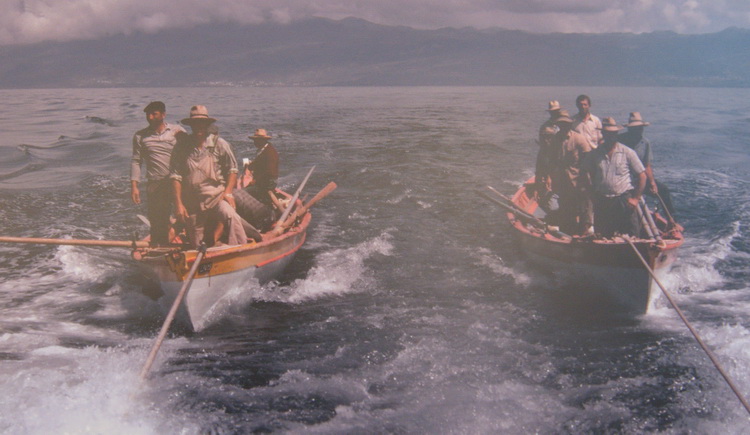
Designed to pursue the deep-water whales out in the open ocean. They targeted the sperm whale because of the highly prized spermaceti wax-like liquid in the whale’s head. Which was used to make expensive candles, that burned with a clear, brilliant light and were in great demand among the wealthy.
Many Azorean men signed on with the American ships. Quickly earning reputations as good “whalemen” who excelled as lookouts, boatmen and harpooners. Plus they did not complain about the low pay, poor conditions and extended 2-3 year trips!
When the American whalers went in to terminal decline, the Azoreans came home and established land-based whaling. With the first known whalery being built on the island of Faial in the 1850’s.
By the early 1900’s Azorean whaling was well established and at its peak there were 21 stations in operation. Which at one point accounted for 40% of the world’s take of sperm whales.

The only concessions made to modern technology was the introduction of motor tow boats in the early 1900’s. So that the open whaler boats could get to the whales much quicker – but the hunt itself was conducted by oar power…
Then radio telephones were introduced in the 1940’s for direct communication between the whale boats and the spotter in their vigias.
I have always viewed whaling as a greedy and evil thing, I still do… But seeing it from the perspective of the Azoreans, who were basically doing what they had to do in the only non-agricultural industry available, allowed me to come to terms with what happened to the sperm whales of the Azores.
Photographing Sperm Whales in the Azores
The total number of sperm whales in and around the Azores archipelago is unclear, but a reasonable estimate is about 2500. So, in an overall area of just under 2400 km² that’s roughly one per km².
However, sperm whales are gregarious animals that often gather in social groups at the surface, which is estimated to happen about 25% of the time. The other 75% is spent foraging in the depths for food – so when a group is encountered the chances of spending much time with them is limited to say the least…
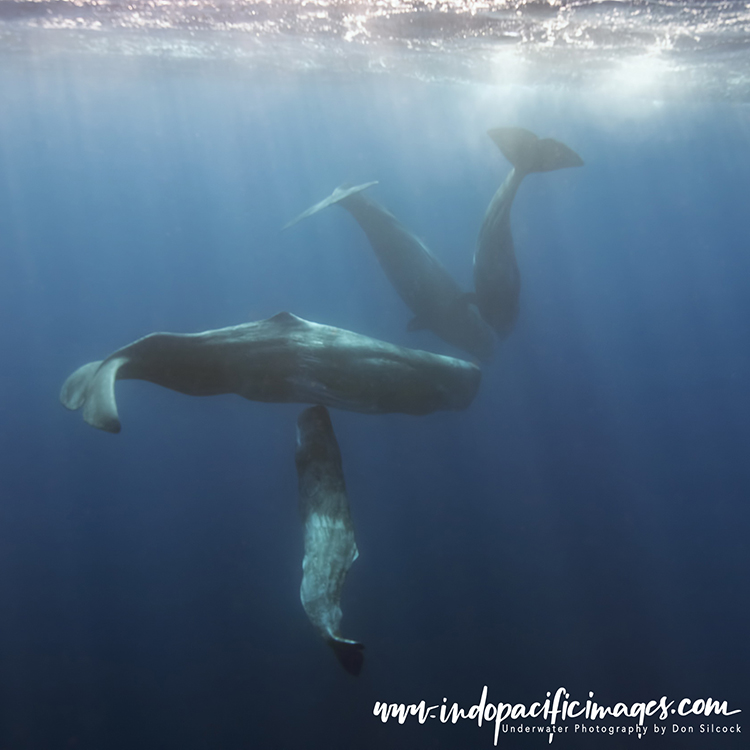
Add to that the fact that whaling ended in the Azores less than 30 years ago and the average age of a sperm whale is believed to be at least 50 years and you can understand their reluctance to linger at the surface when they hear boat engines!
So, while we had many sperm whale encounters, there was virtually no close interaction or intimate moments of connectivity as they typically would move away at best, or dive as we got close…

Other Big Animal Encounters in the Azores
The big positive of being out on the open waters is that you are just a phone call away from the spotters up on high in their vigias.
One day we were out to the far north-west of Faial, looking for a group of sperm whales that had been spotted earlier. When a call came through that there were three pods of false killer whales to the south-east of the island.
Cameras were quickly secured and we took off at full speed in the RIB. That normally carries a full load of whale watchers instead of four whale swimming photographers – fast! Within 40 minutes we were dropped in the water with the first pod which were below us in the blue hunting tuna at an incredible pace!
No Kodak moments were forthcoming, so we got back on the boat and tried the second pod. Quickly coming face to face with a quite aggressive false killer whale! Who proceeded to charge me several times and then ominously circled one of the other swimmers.
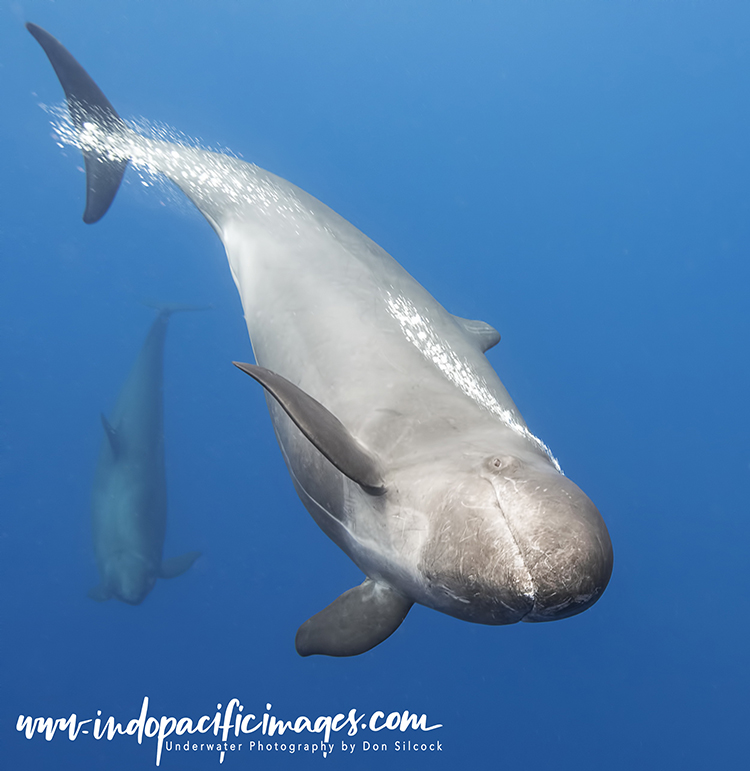
They were a tense and quite exciting few minutes. But the false killer apparently decided against any further moves towards us and returned to the tuna hunt…
Similarly, another day we were just north of Pico and the call came through that there was a pod of pilot whales about 10km south of our current position. And we were able to get in the water with them within minutes.
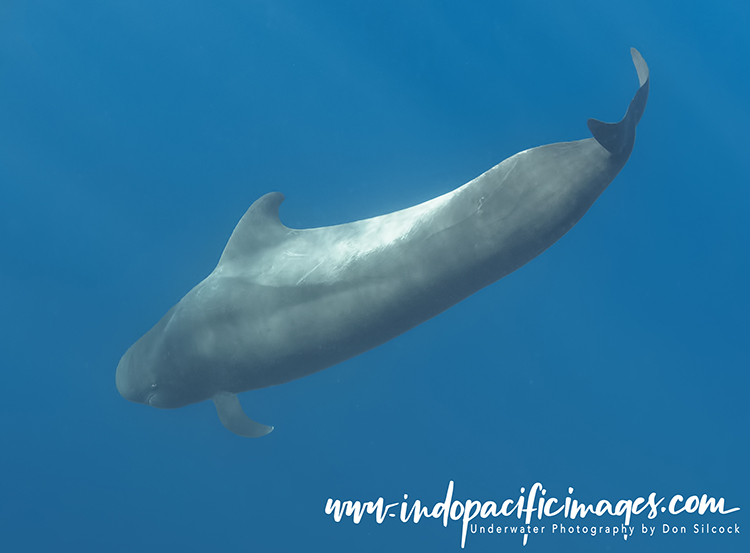
Big Animals in the Azores – Princess Alice
This large submerged seamount is probably the most famous dive in the whole of the Azorean archipelago. Because of its remote location, depth, challenging conditions and the potential encounters that can happen there!
The area was discovered in 1896 by Prince Alfred of Monaco, an accomplished oceanographer and explorer. He named the area the Princess Alice Bank, after his American wife Marie Alice Heine.
What makes the location special from the many other underwater mountains and seamounts of the Azores is that its tip is just 35m below the surface, so it is possible to dive it – just…

It is a large area covering about 100 km², but the seamount is located just over 90 km southwest of Pico Island – hich means a round-trip journey of 6 hours in the open ocean and good conditions are essential for the trip.
The boats anchor on the tip of the seamount, with the mooring line used for both the descent and ascent. Essential to avoid being swept off in to the blue! A typical dive will allow you to spend a few minutes exploring around the seamount peak. With the rest spent on the anchor line waiting for pelagics to come and strut their stuff…
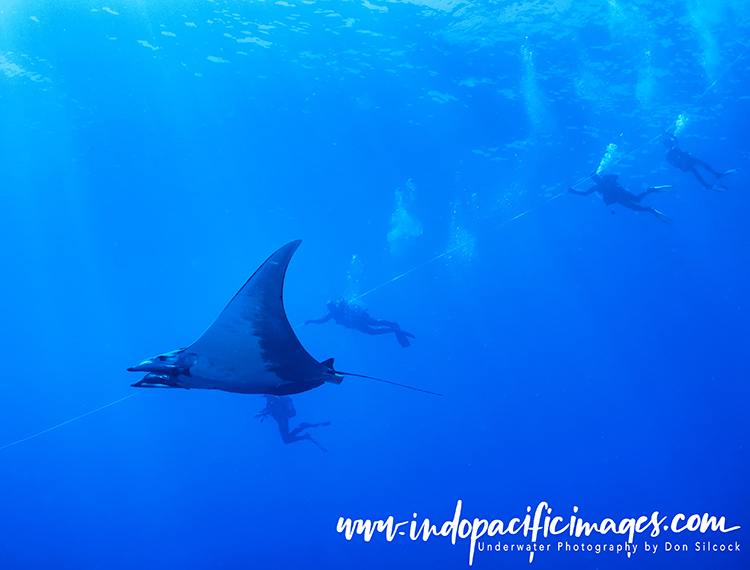
Manta and mobula rays are commonly sighted but many other large creatures like tuna, barracuda and marling often put in an appearance!

Big Animals in the Azores – Blue Sharks
No visit to the Azores would really be complete without experiencing the blue sharks that frequent the deep waters around the islands.
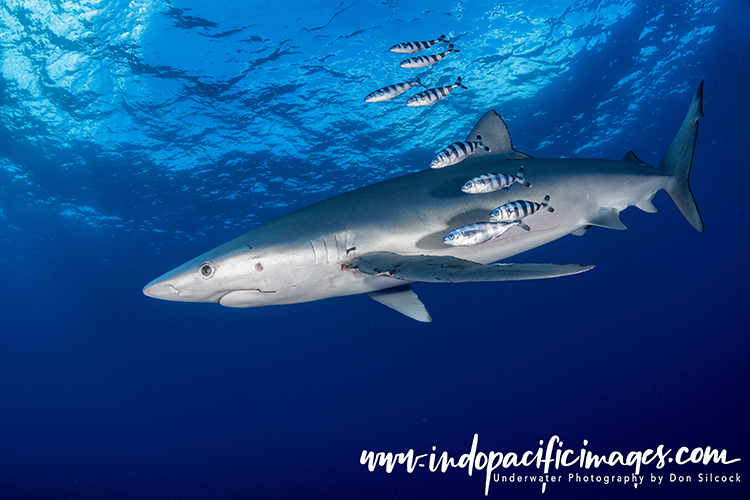
Large and slender-bodied pelagics, mature blue sharks grow to about 3.5m in length. They are found in multiple locations across the Atlantic, Pacific and Indian Oceans and are known to go as deep as 600m below the surface.
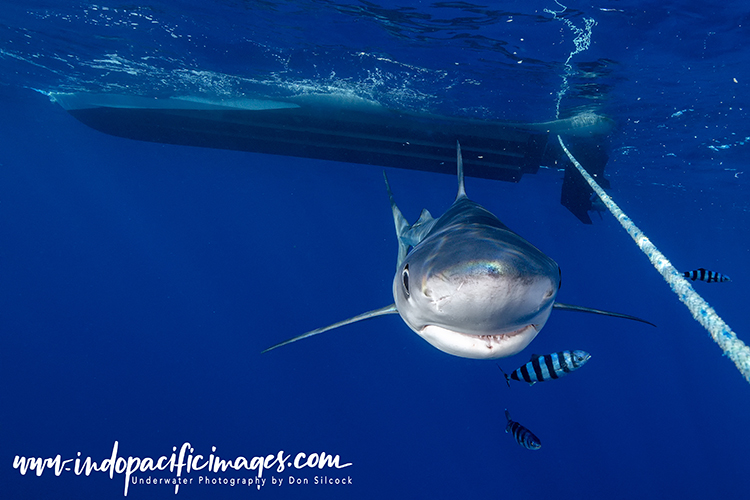
In the Azores they are enticed to the surface by chumming, which creates some great photo-opportunities! As their size, intense curiosity and apparently fearless nature makes for some interesting and very close encounters!
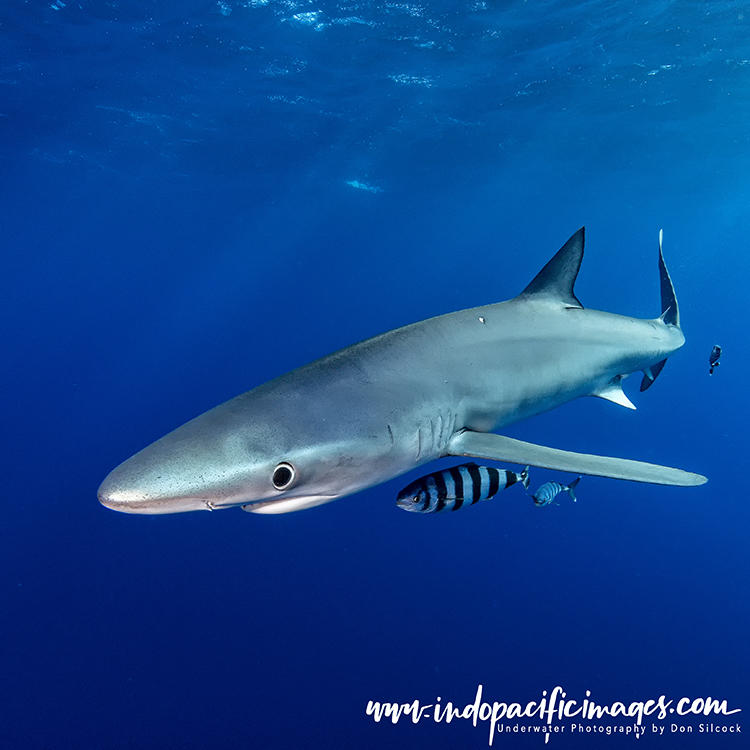
Big Animals in the Azores – In Summary
The Azores is truly a special location… The islands are incredibly scenic, there is a strong local culture and there is a lot to see both above and below the water.
Relatively easy to get to from both Europe and North America, it is a bit of a no-brainer really. Less so if you are traveling all the way from Asia or Australia though… But my three weeks there was truly memorable and I was really glad I did it!
Big Animals in the Azores – ScubaDiver UK Article
The UK version of ScubaDiver magazine recently published an extensive five-page article of mine on the Azores. You can use this link to download the Big Animals in the Azores article in PDF format.
